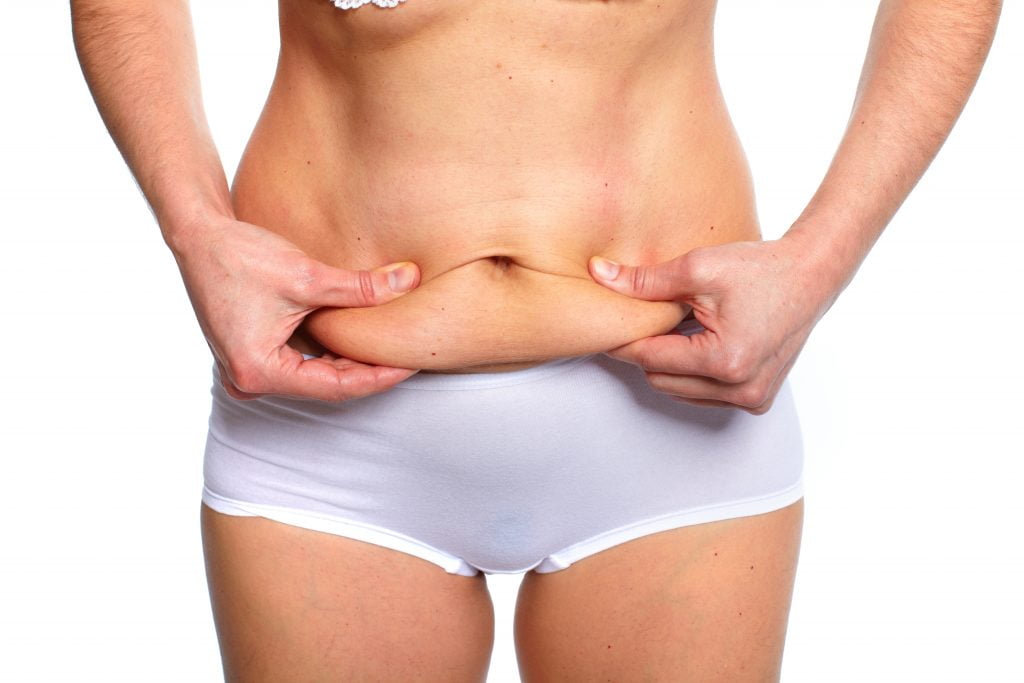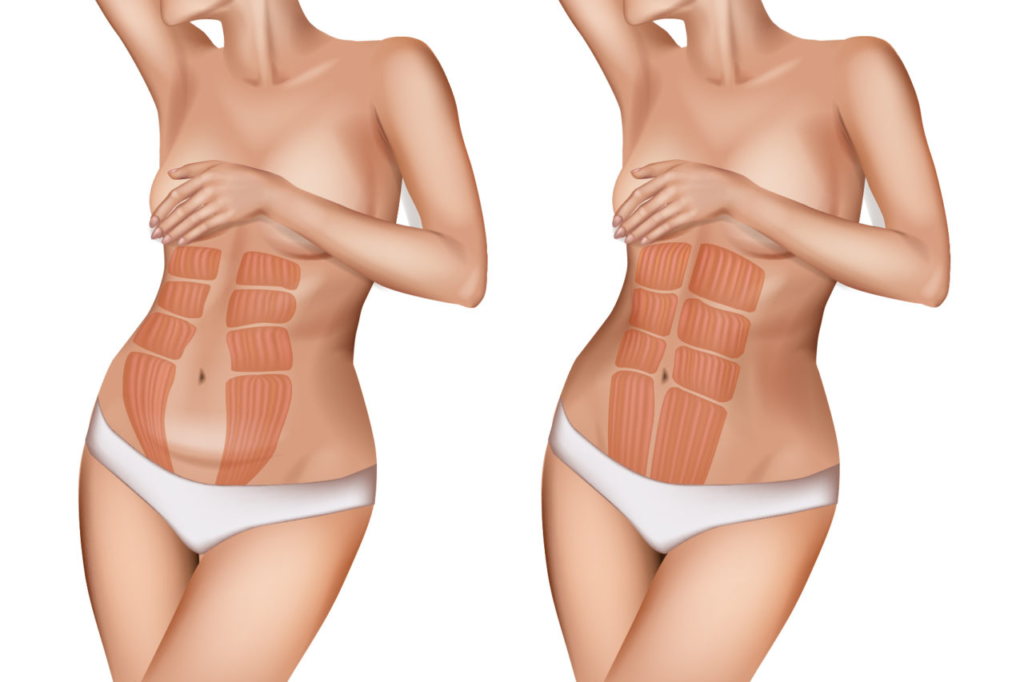Tummy Tuck With Triple Plication>The corset tuck is a 3-vector plication method where the abdominal muscles called the obliques are also tightened. This technique realigns and corsets in the abdominal muscles, creating an even tighter waist and hourglass shape compared to the standard single-vector rectus plication.
When performing tummy tucks as part of a mommy makeover transformation in my practice, I’ll use a technique that I call the corset abdominoplasty or 3-vector plication tummy tuck to reverse the troubling effects of skin and muscle stretching at the midsection.

Tummy Tuck With Triple Plication
A standard abdominoplasty or tummy tuck is a powerful procedure designed to reverse the visible changes brought about by pregnancy and weight fluctuations at the abdominal region. A traditional abdominoplasty involves:
- Removing excess abdominal skin from the belly button to the pubic area.
- Creating a new belly button.
- Tightening the muscles along the abdominal wall, including the repair of the rectus abdominis muscle (rectus diastasis repair).
- Removing unwanted, excess fat to sculpt the waistline with liposuction.
A tummy tuck can include many techniques that flatten and smooth the abdomen. One of these techniques is muscle plication. A common cause of a protruding stomach is diastasis recti which is when the muscles separate. This frequently happens after pregnancy, especially in people who have had multiple pregnancies. It can have other causes such as extreme dieting or damage to the muscles from exercise or injury.
During a tummy tuck surgery, Dr. Sajan can repair the abdominal muscles and tighten them back to their original form. After he has removed extra skin and fat, he will pull the muscles taut and stitch them in place. This can provide a toned, athletic look and repair the “pooch”
look.
This result should last a lifetime, but it is important to commit to a healthy and active lifestyle as future weight gain can reverse muscle plication. This includes future pregnancies. Therefore, it is best to undergo your tummy tuck after you are finished having children.
Abdominal Muscle Plication Surgery
Muscle plication, also called muscle repair, is a surgical technique that tightens the rectus abdominis muscles. This large muscle is technically two muscles joined together by various connective tissues. The rectus abdominis, also known simply as the abdominal muscles, are responsible for the six pack of some people.
Most tummy tuck surgeries use two surgical techniques. First, skin removal is part of nearly every abdominoplasty because it ensures that your skin complements your new contours. Secondly, muscle repair, or muscle plication, is commonly performed during a tummy tuck. This technique provides a tighter, toned abdomen. It can repair the damage done to the body due to pregnancy, weight loss and gain, and even alleviate symptoms of some medical conditions. Dr. Ludwig Allegra of Northwest Face & Body performs the best tummy tuck with muscle plication Bellevue and Kirkland have to offer.
What Is Muscle Plication?
Muscle plication, also called muscle repair, is a surgical technique that tightens the rectus abdominis muscles. This large muscle is technically two muscles joined together by various connective tissues. The rectus abdominis, also known simply as the abdominal muscles, are responsible for the six pack of some people.
The abdominal muscles run from the sternum and down to the pelvis. Due to this, the rectus abdominis muscles play a large role in your anatomy, both cosmetic and medical.
Cosmetically, these muscles can provide the coveted six pack. When in their optimal position, they also provide a more toned look overall. This prevents the stomach from taking on a pooch appearance. Medically, the abdominal muscles help with urination, breathing, and supporting the spine. The rectus abdominis muscles also protect the internal organs.
Pregnancy, weight gain or loss, and previous abdominal surgeries can cause the muscles of the rectus abdominis to separate. While this usually is not dangerous, it can contribute to certain medical and cosmetic problems.
Diastasis Recti:
The medical term for the separation of the abdominal muscles is diastasis recti. The condition is fairly common, especially in women who have been pregnant. As many as 60 percent of women experience the condition following pregnancy. It is not limited to women or those who have been pregnant. Diastasis recti can affect men, women, and even children.
Diastasis recti is the term used to describe when the two segments of the abdominal muscle separate from one another. This weakens the overall structure of the abdomen and can cause a pooch appearance to the stomach. Even at a healthy body weight or with little fat, this look will often persist. This is why muscle plication is often necessary during tummy tuck surgery because without it the patient may not achieve a flat stomach.
Additionally, diastasis recti is tied to some medical conditions usually worsening symptoms. For example, the abdominal muscles can lead to pelvic floor weakness which can cause incontinence. This is especially true after giving birth. Diastasis recti can also cause back and pelvic pain, poor posture, and worsen, or in rare cases, cause hernias. The condition may also contribute to bloating and constipation.
How To Check For Diastasis Recti?
How do you know if you have diastasis recti? If you have given birth or large weight fluctuations, you have a higher chance of diastasis recti. It is important to see a certified professional who can diagnose diastasis recti like Dr. Allegra. However, you can self check to determine if you may be experiencing muscle separation.
To check for muscle plication, you will first need to lay back on the floor. Keep your knees bent comfortably. Then, place your fingertips along the middle of your stomach, about halfway between your waist and bellybutton. Use your other hand to support your head and neck. Finally, slowly lift your head and apply pressure downward against your abdomen.
If you do not have diastasis recti, you will likely feel hard, toned muscles. If your fingers sink or feel space, you may have diastasis recti. The condition is not always associated with a stomach bulge and can occur anywhere among the abdominal muscles. Therefore, it can be difficult to tell on your own.
Tummy Tuck With Muscle Plication
At Northwest Face & Body, Dr. Allegra performs muscle plication and correction of diastasis recti as part of tummy tuck procedures. While a tummy tuck does not always include muscle plication, it is part of most abdominoplasty procedures Dr. Allegra does.
If you undergo a tummy tuck with muscle plication, you will come to Northwest Face & Body’s Medicare certified surgical center. After check-in, marking, and clearance for surgery, a licensed anesthesia provider will place you under general anesthesia.
Dr. Allegra will then make an incision from hip to hip. The incision may be longer or shorter depending on your specific needs for tummy tuck surgery in Bellevue. A mini tummy tuck uses a shorter scar, while an extended tummy tuck uses a longer scar. Through this incision, he will repair the muscles and pull them tight. Dr. Allegra will then remove extra skin and tissue to accommodate for your tighter muscles.

Muscle Plication Tummy Tuck
Not all tummy tucks are alike. Some involve more extensive surgery than others, and for this reason, what to expect during recovery can vary from person to person. The aim of the tummy tuck is to slim and tighten the waist for a more shapely and youthful appearance, but the surgical route to get you there (and into some cute new clothes) can vary quite a bit.
Depending on the amount of excess skin and fat to be removed, incisions can be shorter or more extensive, including the repositioning of the belly button. But one of the biggest factors to impact recovery from a tummy tuck, also called an abdominoplasty, is whether or not a muscle repair is included.
Why the muscle sometimes needs a repair
If you have seen the abs on even one superhero you will know the muscle we are talking about. It is called the rectus abdominis and it runs vertically from your sternum to your pubic bone. It has a left and right side separated down the middle by a band of tissue called the linea alba.
The linea alba can become over stretched, usually during pregnancy but also due to extreme weight gain or a lifting injury. When this happens the two sides of the muscle move further apart, resulting in an outward bulging of the belly that doesn’t go away, even when weight (baby or otherwise) is gone. This condition is called diastasis recti.
Besides being a cosmetic issue for some people, this condition can affect posture and trunk strength. It can cause pain in the abdomen, hips, and back, as well as bowel and bladder issues, all of which can have a huge impact on quality of life.
Why the muscle sometimes doesn’t need a repair
Not all tummy tucks include a muscle repair because not all bellies that can benefit from a tummy tuck have a diastasis recti. Even when the linea alba is stretched out, it can sometimes return to its normal size on its own. Furthermore, if a woman has had a cesarean section, a repair will likely have already been completed at that time.
How the muscle is repaired
Diastasis recti can be corrected by a general surgeon, but plastic surgeons routinely do this as part of their tummy tuck procedure. The surgery involves folding over the stretched tissue of the linea alba and suturing the two sides of the rectus abdominis muscle together. Though you can’t see it from the outside of the body, this involves suturing up and down the whole length of the abdomen.
Why a muscle repair impacts tummy tuck recovery
The difference in recovery between a tummy tuck with muscle repair versus one without has to do with the fact that muscles contract. Unlike the skin and fatty tissue that cover the abdomen, the muscles underneath (and the rectus abdominis is a big one) are prime movers and stabilizers of the whole trunk. This means that they contract nearly any time you move your body. Even simple movements like lifting your arms when sitting upright or rolling over in bed can engage these muscles — and then there’s coughing and sneezing.